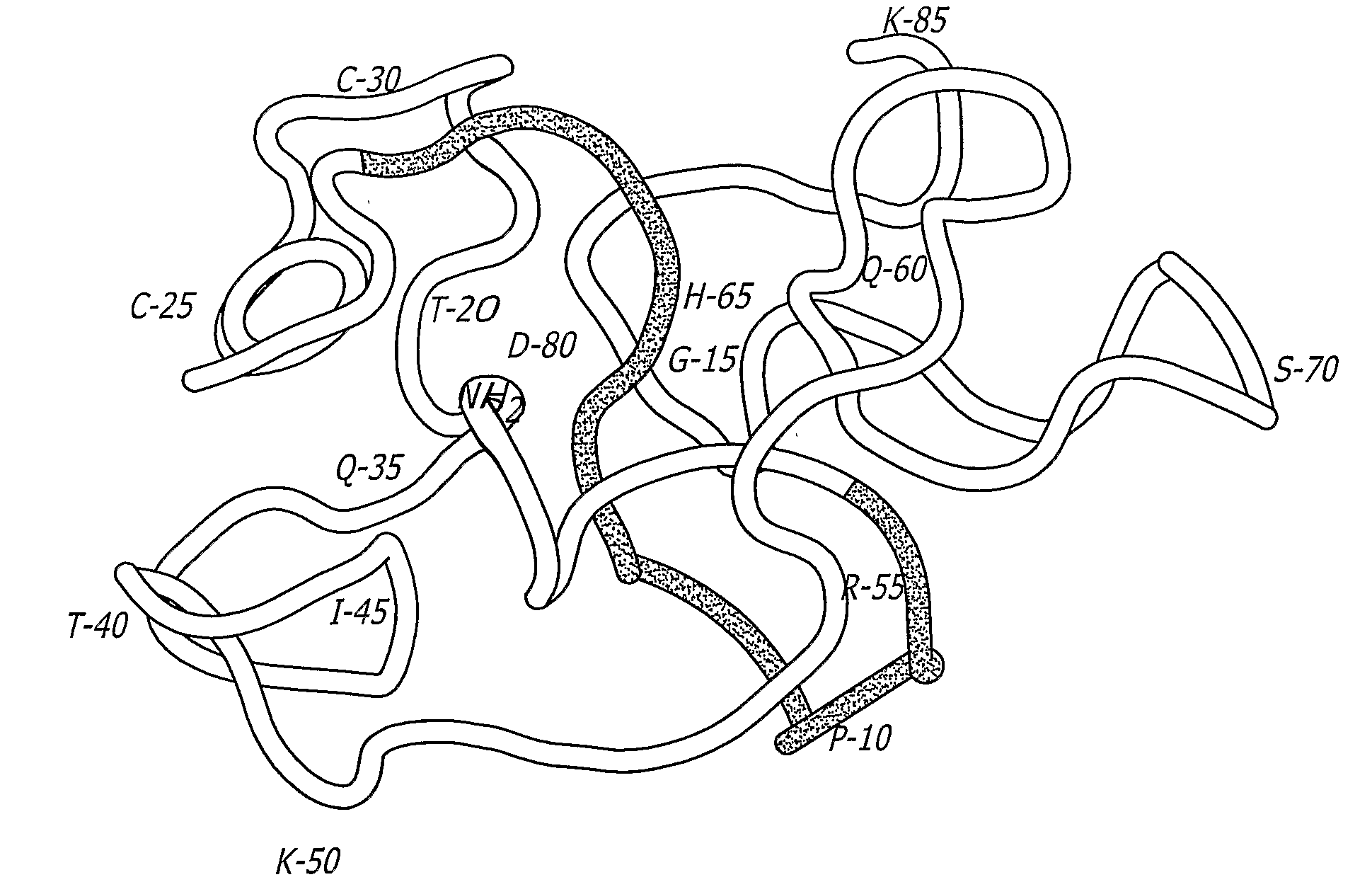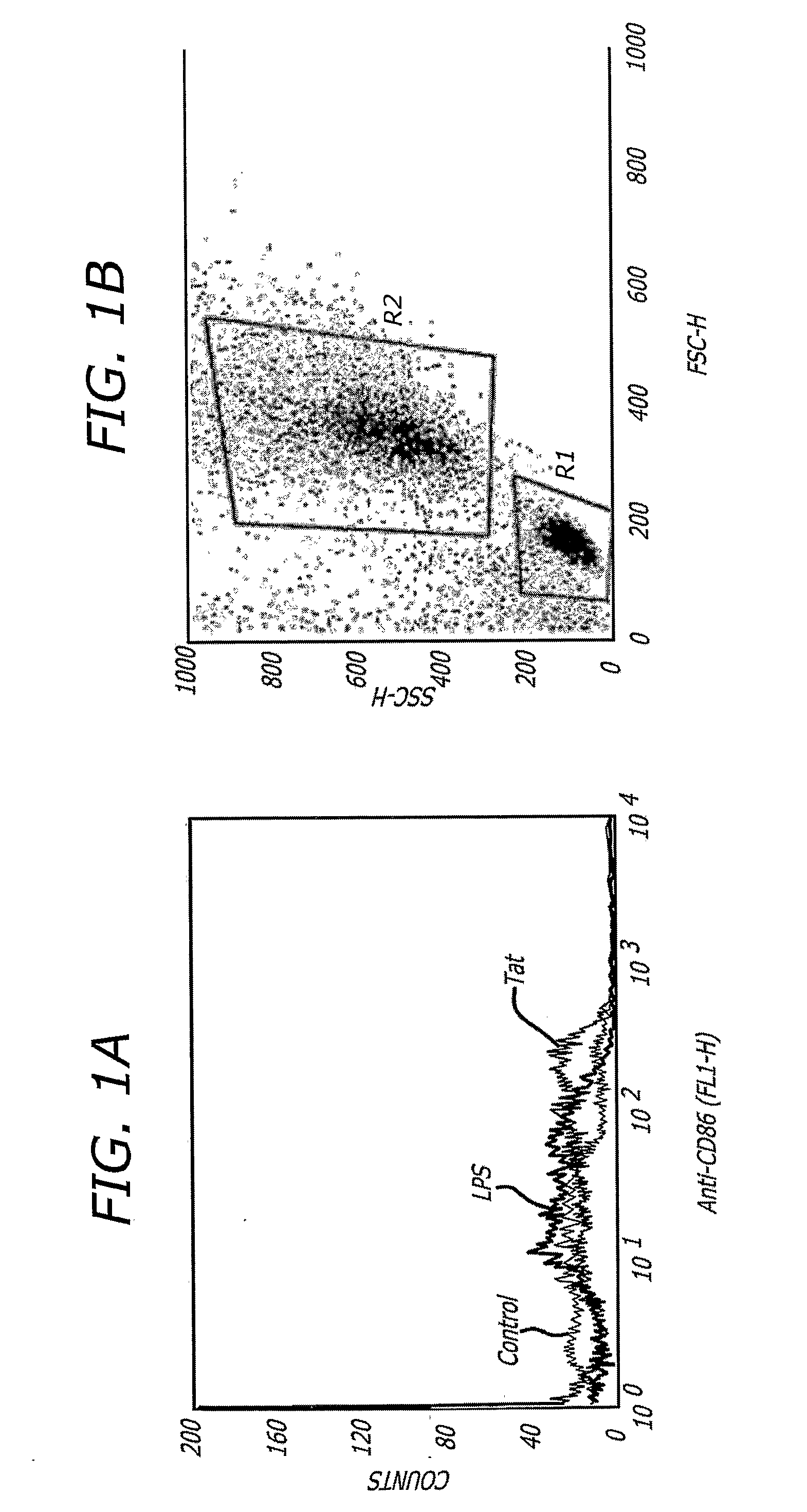Tat-Based vaccine Compositions and Methods of Making and Using Same
a technology of tat-based vaccines and compositions, applied in the field of immunomodulation therapeutics, can solve the problems of extreme immunosuppression, significant reduction of t4 cells, and inability to explain the seemingly immediate and profound destruction of the immune system
- Summary
- Abstract
- Description
- Claims
- Application Information
AI Technical Summary
Benefits of technology
Problems solved by technology
Method used
Image
Examples
example 1
Derivatization of Tat to Promote Stimulatory Activities
[0068] Conventional immunosuppressive HIV Tat is chemically or physically derivatized to form immunostimulatory Tat*. These Tat proteins are derivatized to reduce or eliminate their immunosuppressive activity, which is verified using the in vitro macrophage bioassay described in Example 6. The chemical and physical methods used to derivatize Tat include, but are not limited to, chemical oxidation and irradiation.
[0069] In one embodiment of the present invention, Tat proteins are chemically oxidized using 3% hydrogen peroxide for one hour at approximately 25° C. Other methods for chemical oxidation include: 1 mM to 1 M sodium periodate for one hour at approximately 25° C., 1 mM to 1 M peroxyacids for one hour at approximately 25° C.; 1 mM to 1 M m-chloroperbenzoic acid for one hour at approximately 25° C.; and other chemical and physical oxidative processes known to those skilled in the art. Residual oxidants can be eliminated ...
example 2
Effects of Tat on the Dendritic Cell Lineage
[0070] An additional embodiment of the present invention is that Tat induces monocytes committed to the dendritic cell (DC) lineage to enlarge into activated, CD86+ DC APCs (FIG. 1). Human monocytes enriched from PBMCs by Percoll density gradient separation and adherance to anti-CD14 coated magnetic beads (Dynabeads M-450, Dynal Biotech) were committed to differentiate into DCs through five days of culture in GM-CSF (100 ng / mL) and IL-4 (100 ng / mL). Committed DCs were cultured overnight either in medium alone (Control), LPS (100 ng / mL), or Tat (50 nM), after which they were stained with an anti-CD86 antibody (BD Pharmingen) and analyzed by FACScan for CD86 induction (left panel) or generalized activation (right panel, enlargement into box R2, shown for Tat-stimulated cells). The MFIs for CD86 expression are 9 (Control), 30 (LPS), and 187 (Tat), CD86 being a specific determinant of DC activation.
[0071] Derivitzed Tat reduces AReg differen...
example 3
Re-activation of Suppressed T Lymphocytes by Vaccine Compositions
[0072] As depicted in FIG. 15, alloreactive human peripheral blood mononuclear cells (PBMC) were maintained in interleukin-2 rich medium (10 μg / mL) for 2 weeks. A that time, the cells were harvested and re-stimulated in the presence of 103 fresh irradiated allogeneic PBMCs (Ag) either in the absence (APC) or presence (APC+PINS) of the vaccine composition of the present invention (100 ng / mL). Additional cytokine stimuli were added as indicated at 10 μg / mL each. GM stands for granulocyte macrophage colony stimulating factor (GM-CSF).
[0073] Cytokines alone were unable to stimulate proliferation of the alloreactive PBMCs however addition of the vaccine composition (PINS) led to induction of significant T cell proliferation (FIG. 15).
PUM
| Property | Measurement | Unit |
|---|---|---|
| Immunostimulation | aaaaa | aaaaa |
Abstract
Description
Claims
Application Information
 Login to View More
Login to View More - R&D
- Intellectual Property
- Life Sciences
- Materials
- Tech Scout
- Unparalleled Data Quality
- Higher Quality Content
- 60% Fewer Hallucinations
Browse by: Latest US Patents, China's latest patents, Technical Efficacy Thesaurus, Application Domain, Technology Topic, Popular Technical Reports.
© 2025 PatSnap. All rights reserved.Legal|Privacy policy|Modern Slavery Act Transparency Statement|Sitemap|About US| Contact US: help@patsnap.com



